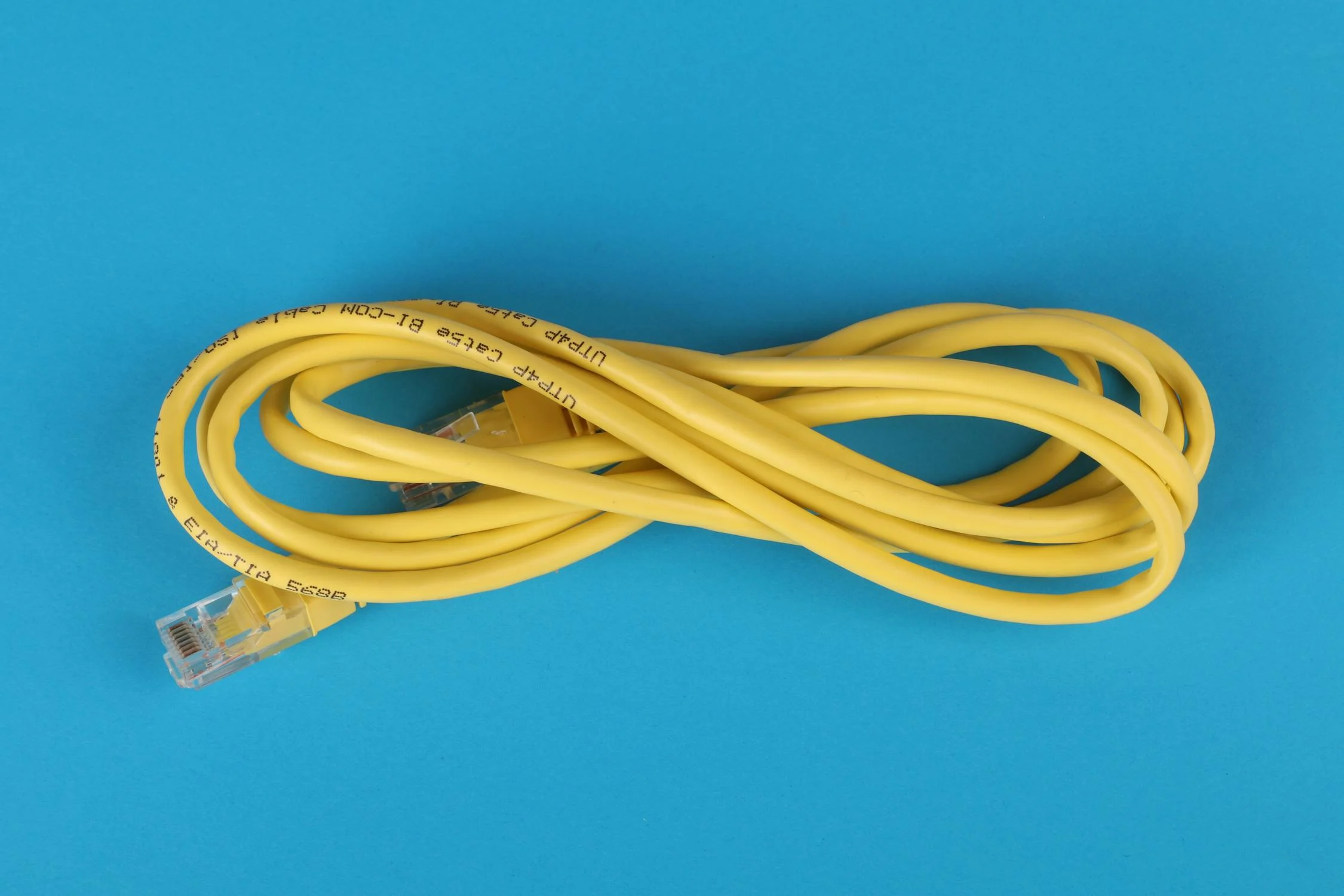How Do I Choose The Best Ethernet Cable?
Mon Sep 09 2024
|netservicesDiscover the best Ethernet cables for your needs. Learn about different categories, features, and top picks to enhance your internet connection.

Ethernet cables are the unsung heroes of our connected world. They’re the physical links that carry data between our devices and the internet. But not all Ethernet cables are created equal. The category, or “Cat,” of an Ethernet cable determines its performance capabilities.
The most common Ethernet cable categories you’ll encounter are Cat5e, Cat6, Cat6a, Cat7, and Cat8. Each successive category offers improvements in speed, bandwidth, and shielding. For instance, Cat5e cables support speeds up to 1 Gbps, while Cat8 cables can handle a whopping 40 Gbps.
Understanding these categories is crucial when choosing the best Ethernet cable for your needs. Whether you’re a casual internet user or a hardcore gamer, knowing the differences between these categories will help you make an informed decision.
Why Ethernet Cables Matter for Your Internet Connection
You might be wondering, “Why should I care about Ethernet cables when I have Wi-Fi?” While wireless connections are convenient, Ethernet cables offer several advantages that can significantly improve your internet experience.
Firstly, Ethernet connections are generally faster and more stable than Wi-Fi. They’re not subject to interference from other wireless devices or physical obstacles. This means you’ll experience less lag, fewer dropped connections, and faster download and upload speeds. For activities like online gaming, video streaming, or large file transfers, a good Ethernet cable can make a world of difference.
Secondly, Ethernet connections are more secure. Unlike Wi-Fi signals that can be intercepted by nearby devices, data transmitted through an Ethernet cable stays within the cable. This added layer of security is particularly important for businesses or anyone handling sensitive information.
Comparing Cat5e, Cat6, Cat6a, Cat7, and Cat8 Cables
Let’s break down the key differences between the most common Ethernet cable categories:
- Cat5e: Supports speeds up to 1 Gbps and frequencies up to 100 MHz. It’s the most basic option for modern networks.
- Cat6: Offers speeds up to 10 Gbps over shorter distances (up to 55 meters) and frequencies up to 250 MHz.
- Cat6a: Extends the 10 Gbps speeds of Cat6 to 100 meters and supports frequencies up to 500 MHz.
- Cat7: Supports speeds up to 100 Gbps over very short distances and frequencies up to 600 MHz. However, it’s not widely adopted due to compatibility issues.
- Cat8: The newest standard, supporting speeds up to 40 Gbps and frequencies up to 2000 MHz, but over shorter distances (up to 30 meters).
When choosing between these categories, consider your internet speed, the distance you need to cover, and your future needs. For most home users, Cat6 or Cat6a cables offer a good balance of performance and cost.
Top Picks for Different Needs: Gaming, Streaming, and More
Different activities have different demands when it comes to Ethernet cables. Here are some top picks for various needs:
For gaming: The DbillionDa Cat 8 Ethernet cable is an excellent choice for serious gamers. Its high bandwidth and low latency ensure smooth gameplay and quick response times.
For streaming: The Cable Matters Cat6a cable is perfect for streaming 4K content without buffering. It offers reliable 10 Gbps speeds over longer distances.
For home office use: The AmazonBasics Cat6 Ethernet cable provides a good balance of performance and affordability for everyday tasks like video conferencing and file sharing.
For outdoor use: The GearIT Cat6 Direct Burial cable is designed to withstand the elements, making it ideal for connecting outdoor devices or running cables between buildings.
How to Choose the Right Length for Your Ethernet Cable
Choosing the right length for your Ethernet cable is crucial for both performance and aesthetics. A cable that’s too short won’t reach your device, while one that’s too long can create clutter and potentially impact signal quality over very long distances.
To determine the ideal length:
1. Measure the distance between your router or network switch and the device you want to connect.
2. Add an extra 1-2 feet to allow for some flexibility and future adjustments.
3. Consider the path the cable will take. If it needs to go around corners or along baseboards, factor in this additional length.
Remember, while longer cables can be convenient, extremely long runs (over 100 meters) may result in signal degradation. If you need to cover longer distances, consider using network switches or repeaters to boost the signal.
The Importance of Shielding in Ethernet Cables
Shielding is a crucial feature in Ethernet cables, especially in environments with high electromagnetic interference (EMI). Shielded cables have an extra layer of metal foil or braided copper mesh that protects the internal wires from external noise.
There are several types of shielding:
- UTP (Unshielded Twisted Pair): No shielding, suitable for most home environments.
- FTP (Foiled Twisted Pair): Each pair is wrapped in foil.
- STP (Shielded Twisted Pair): Each pair is individually shielded, and the entire cable has an overall shield.
- S/FTP (Screened Foiled Twisted Pair): Combines individual foil shields with an overall braid shield.
For most home users, UTP cables are sufficient. However, if you live in an area with high EMI (like near power lines or heavy machinery), or if you’re running cables alongside power cables, consider a shielded option for better performance.
Braided vs. Non-Braided Ethernet Cables: Pros and Cons
When shopping for Ethernet cables, you’ll encounter both braided and non-braided options. Each has its advantages and disadvantages:
Braided cables:
– Pros: More durable, resistant to tangling, often more visually appealing.
– Cons: Usually more expensive, can be stiffer and harder to route in tight spaces.
Non-braided cables:
– Pros: Generally more flexible, easier to route through small spaces, often cheaper.
– Cons: Less durable, more prone to tangling and wear over time.
For stationary setups, non-braided cables are usually sufficient. However, if you frequently move or adjust your equipment, or if the cable will be exposed to potential wear and tear, a braided cable might be a better choice.
Best Ethernet Cables for Outdoor Use
Outdoor Ethernet cables need to withstand various environmental challenges, including UV rays, moisture, and temperature fluctuations. When choosing an Ethernet cable for outdoor use, look for these features:
- UV resistance to prevent degradation from sunlight exposure.
- Waterproof or water-resistant construction.
- A durable outer jacket, often made of PVC or polyethylene.
- “Direct burial” rating if you plan to run the cable underground.
Some top picks for outdoor Ethernet cables include:
- Ubiquiti Tough Cable Pro: A rugged Cat5e cable designed for outdoor use.
- GearIT Cat6 Direct Burial Cable: Suitable for both direct burial and outdoor runs.
- Outdoor Cat7 Ethernet Cable by Dekomusic: A high-performance option with double shielding for extra protection.
Remember to use weatherproof junction boxes for any connections made outdoors to ensure your network stays protected from the elements.
Tips for Installing and Maintaining Your Ethernet Cable
Proper installation and maintenance of your Ethernet cable can significantly extend its lifespan and ensure optimal performance. Here are some tips:
1. Avoid sharp bends: Ethernet cables shouldn’t be bent at angles sharper than 90 degrees. Use gentle curves instead.
2. Don’t stretch the cable: Leave some slack to prevent strain on the connectors.
3. Use cable management: Organize your cables with zip ties or cable clips to prevent tangling and make troubleshooting easier.
4. Keep away from heat sources: Avoid running cables near radiators or in direct sunlight.
5. Regular cleaning: Dust can accumulate on cables and connectors. Gently clean them with a dry cloth periodically.
6. Check for damage: Regularly inspect your cables for any signs of wear or damage, especially near the connectors.
7. Use wall mounts or cable raceways: These can protect your cables and improve the aesthetics of your setup.
By following these tips, you can ensure your Ethernet cable installation is not only effective but also long-lasting.
Where to Buy the Best Ethernet Cables
When it comes to purchasing Ethernet cables, you have several options:
1. Online marketplaces: Amazon and Newegg offer a wide variety of Ethernet cables at competitive prices. You can easily compare different brands and read customer reviews.
2. Electronics stores: Retailers like Best Buy or Micro Center stock Ethernet cables and offer the advantage of immediate availability and the ability to see the product before buying.
3. Specialty cable retailers: Websites like Monoprice or Cable Matters specialize in cables and often offer high-quality products at reasonable prices.
4. Local computer stores: These can be a good option if you need a cable quickly and want personalized advice.
When buying, always check the cable’s specifications to ensure it meets your needs. Look for reputable brands and be wary of deals that seem too good to be true – extremely cheap cables may be of lower quality or use inferior materials.
Frequently Asked Questions About Ethernet Cables
Q: Can I use an Ethernet cable for my gaming console?
A: Yes, most modern gaming consoles have Ethernet ports and can benefit from a wired connection for faster, more stable online gaming.
Q: Do Ethernet cables affect internet speed?
A: The cable itself doesn’t increase your internet speed beyond what your ISP provides, but a good quality cable ensures you’re getting the full speed you’re paying for without signal loss.
Q: How long can an Ethernet cable be before losing signal quality?
A: Most Ethernet cables can run up to 100 meters (328 feet) without significant signal degradation. For longer distances, you may need signal boosters or fiber optic cables.
Q: Are more expensive Ethernet cables worth it?
A: Not always. While higher quality cables can offer better shielding and durability, for most home users, a standard Cat6 cable will suffice. Extremely cheap cables, however, may use inferior materials that could affect performance.
Q: Can I run an Ethernet cable next to power cables?
A: It’s best to keep Ethernet cables away from power cables to avoid interference. If they must cross, do so at right angles. For parallel runs, maintain at least 8 inches of separation.
Q: How often should I replace my Ethernet cable?
A: There’s no set lifespan for Ethernet cables. As long as the cable isn’t physically damaged and is performing well, there’s no need to replace it. However, if you’re using very old cables (Cat5 or earlier), upgrading could improve your network performance.
Remember, the best Ethernet cable for you depends on your specific needs, setup, and budget. By understanding the different types and features of Ethernet cables, you can make an informed decision that will enhance your internet experience.



